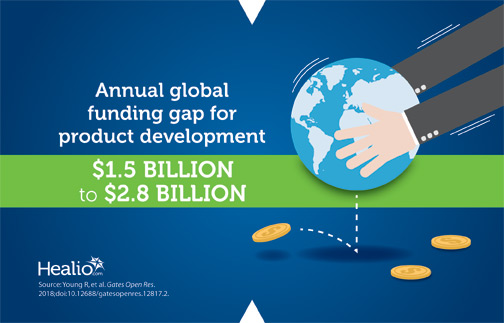Study finds vaccine pipeline grossly underfunded
Global spending on research into “game-changing” products like vaccines for hepatitis C virus, HIV, malaria and tuberculosis is underfunded by as much as $2.8 billion per year, researchers reported recently in Gates Open Research.
“Investing in the development and delivery of health technologies is one of the most effective ways to achieve rapid reductions in avertable mortality,” Gavin Yamey, MD, MPH, director of the Center for Policy Impact in Global Health at the Duke Global Health Institute, and colleagues wrote. “Yet funding for neglected disease product development fell steadily from 2009 to 2015, with the exception of a short-term injection of Ebola funding.”
Yamey and colleagues conducted a pipeline portfolio review that identified, as of Aug. 31, 2017, 538 disease product candidates for 35 neglected diseases — a term they used for 35 infections or health priorities defined as neglected by Policy Cures Research. These include HIV/AIDS, malaria, tuberculosis, pneumonia, diarrheal diseases, neglected tropical diseases and reproductive health needs of developing countries. Yamey and colleagues listed what they said were 18 important “missing” products: vaccines against HCV, HIV, malaria and TB; a combined vaccine against multiple diarrheal diseases; a complex new chemical entity (NCE) for TB; and NCEs for 12 neglected tropical diseases.
They estimated it would cost approximately $16.3 billion to move the 538 candidates through the pipeline over the next decade, with three-quarters of the costs coming in the first 5 years. They projected about 128 product launches.
According to Yamey and colleagues, “launches of highly efficacious HIV, tuberculosis or malaria vaccines would be unlikely.” They estimated the additional cost of launching one of each of the 18 key missing products to be $13.6 billion to $21.8 billion.
When they assessed the amount it would take to move current candidates through the pipeline, along with developing 18 low-complexity missing products, they found it would cost about $4.5 billion a year over the next 5 years. With high-complexity missing products, it would cost $5.8 billion per year, according to the study.
Yamey and colleagues said approximately $3 billion is spent globally on product development, annually, suggesting that the annual funding gap is $1.5 to $2.8 billion over the next 5 years.
“Closing this large financing gap will require a major effort to mobilize new resources from across the public, philanthropic, and private sectors,” they wrote. – by Marley Ghizzone
Disclosures: Yamey reports no relevant financial disclosures. Please see the study for all other authors’ relevant financial disclosures.

